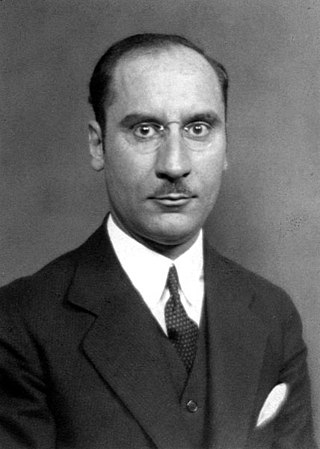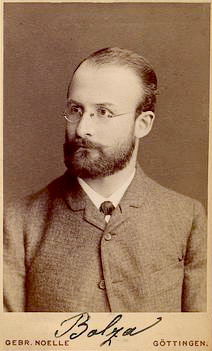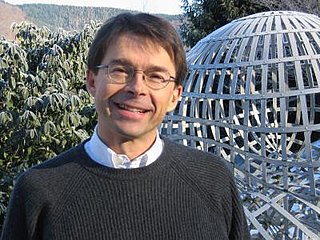Related Research Articles
In mathematical analysis, a function of bounded variation, also known as BV function, is a real-valued function whose total variation is bounded (finite): the graph of a function having this property is well behaved in a precise sense. For a continuous function of a single variable, being of bounded variation means that the distance along the direction of the y-axis, neglecting the contribution of motion along x-axis, traveled by a point moving along the graph has a finite value. For a continuous function of several variables, the meaning of the definition is the same, except for the fact that the continuous path to be considered cannot be the whole graph of the given function, but can be every intersection of the graph itself with a hyperplane parallel to a fixed x-axis and to the y-axis.
Jürgen Kurt Moser was a German-American mathematician, honored for work spanning over four decades, including Hamiltonian dynamical systems and partial differential equations.

Ennio De Giorgi, a member of the House of Giorgi, was an Italian mathematician who worked on partial differential equations and the foundations of mathematics.
Hilbert's nineteenth problem is one of the 23 Hilbert problems, set out in a list compiled in 1900 by David Hilbert. It asks whether the solutions of regular problems in the calculus of variations are always analytic. Informally, and perhaps less directly, since Hilbert's concept of a "regular variational problem" identifies precisely a variational problem whose Euler–Lagrange equation is an elliptic partial differential equation with analytic coefficients, Hilbert's nineteenth problem, despite its seemingly technical statement, simply asks whether, in this class of partial differential equations, any solution function inherits the relatively simple and well understood structure from the solved equation. Hilbert's nineteenth problem was solved independently in the late 1950s by Ennio De Giorgi and John Forbes Nash, Jr.
In mathematics, the Hasse invariant (or Hasse–Witt invariant) of a quadratic form Q over a field K takes values in the Brauer group Br(K). The name "Hasse–Witt" comes from Helmut Hasse and Ernst Witt.

Renato Caccioppoli was an Italian mathematician, known for his contributions to mathematical analysis, including the theory of functions of several complex variables, functional analysis, measure theory.
In mathematics, a (real) Monge–Ampère equation is a nonlinear second-order partial differential equation of special kind. A second-order equation for the unknown function u of two variables x,y is of Monge–Ampère type if it is linear in the determinant of the Hessian matrix of u and in the second-order partial derivatives of u. The independent variables (x,y) vary over a given domain D of R2. The term also applies to analogous equations with n independent variables. The most complete results so far have been obtained when the equation is elliptic.

Leonida Tonelli was an Italian mathematician, noted for creating Tonelli's theorem, a variation of Fubini's theorem, and for introducing semicontinuity methods as a common tool for the direct method in the calculus of variations.

Oskar Bolza was a German mathematician, and student of Felix Klein. He was born in Bad Bergzabern, Palatinate, then a district of Bavaria, known for his research in the calculus of variations, particularly influenced by Karl Weierstrass' 1879 lectures on the subject.
Vladimir Gilelevich Maz'ya is a Russian-born Swedish mathematician, hailed as "one of the most distinguished analysts of our time" and as "an outstanding mathematician of worldwide reputation", who strongly influenced the development of mathematical analysis and the theory of partial differential equations.
Frederick Justin Almgren Jr. was an American mathematician working in geometric measure theory. He was born in Birmingham, Alabama.
Lamberto Cesari was an Italian mathematician naturalized in the United States, known for his work on the theory of surface area, the theory of functions of bounded variation, the theory of optimal control and on the stability theory of dynamical systems: in particular, by extending the concept of Tonelli plane variation, he succeeded in introducing the class of functions of bounded variation of several variables in its full generality.

Charles Bradfield Morrey Jr. was an American mathematician who made fundamental contributions to the calculus of variations and the theory of partial differential equations.
Aizik Isaakovich Vol'pert was a Soviet and Israeli mathematician and chemical engineer working in partial differential equations, functions of bounded variation and chemical kinetics.

Enrico Giusti, is an Italian mathematician mainly known for his contributions to the fields of calculus of variations, regularity theory of partial differential equations, minimal surfaces and history of mathematics. He has been professor of mathematics at the Università di Firenze; he also taught and conducted research at the Australian National University at Canberra, at the Stanford University and at the University of California, Berkeley. After retirement, he devoted himself to the managing of the "Giardino di Archimede", a museum entirely dedicated to mathematics and its applications. Giusti is also the editor-in-chief of the international journal, dedicated to the history of mathematics "Bollettino di storia delle scienze matematiche".
In mathematics, the Morrey–Campanato spaces are Banach spaces which extend the notion of functions of bounded mean oscillation, describing situations where the oscillation of the function in a ball is proportional to some power of the radius other than the dimension. They are used in the theory of elliptic partial differential equations, since for certain values of , elements of the space are Hölder continuous functions over the domain .

Giuseppe Mingione is an Italian mathematician who is active in the fields of partial differential equations and calculus of variations.

Michael Struwe is a German mathematician who specializes in calculus of variations and nonlinear partial differential equations. He won the 2012 Cantor medal from the Deutsche Mathematiker-Vereinigung for "outstanding achievements in the field of geometric analysis, calculus of variations and nonlinear partial differential equations".

Luigi Amerio, was an Italian electrical engineer and mathematician. He is known for his work on almost periodic functions, on Laplace transforms in one and several dimensions, and on the theory of elliptic partial differential equations.
Carlo Miranda was an Italian mathematician, working on mathematical analysis, theory of elliptic partial differential equations and complex analysis: he is known for giving the first proof of the Poincaré–Miranda theorem, for Miranda's theorem in complex analysis, and for writing an influential monograph in the theory of elliptic partial differential equations.
References
- ↑ "Mariano Giaquinta". MATEpristem. Retrieved 2 August 2012.
- ↑ "La Cultura e la Scienza". Treccani.it. Retrieved 2 August 2012.
- ↑ "Matematica nelle Scienze Naturali e Sociali". Centro di Ricerca Matematica Ennio De Giorgi. Retrieved 2 August 2012.
- ↑ M. Giaquinta, E. Giusti: "On the regularity of the minima of variational integrals" in Acta Mathematica 148 (1982), 31–46
- ↑ M. Giaquinta, E. Giusti: "Differentiability of minima of nondifferentiable functionals" in Inventiones Mathematicae 72 (1983), 285–298
- ↑ M. Giaquinta, E. Giusti: "The singular set of the minima of certain quadratic functionals" in Annali della Scuola Normale Superiore di Pisa Classe di Scienze (Serie 4) 11 (1984), 45–55
- ↑ M. Giaquinta, G. Modica: "Regularity results for some classes of higher order nonlinear elliptic systems" in Journal fuer die Reine und Angewandte Mathematik (Crelles J.), 311/312 (1979), pp145-169
- ↑ M. Giaquinta, "Multiple integrals in the calculus of variations and nonlinear elliptic systems", in Annals of Mathematics Studies, 105. Princeton University Press, Princeton, New Jersey, 1983. ISBN 0-691-08330-4; 0-691-08331-2
- ↑ "Highly Cited Research". Thomson Reuters. Archived from the original on 28 March 2013. Retrieved 2 August 2012.